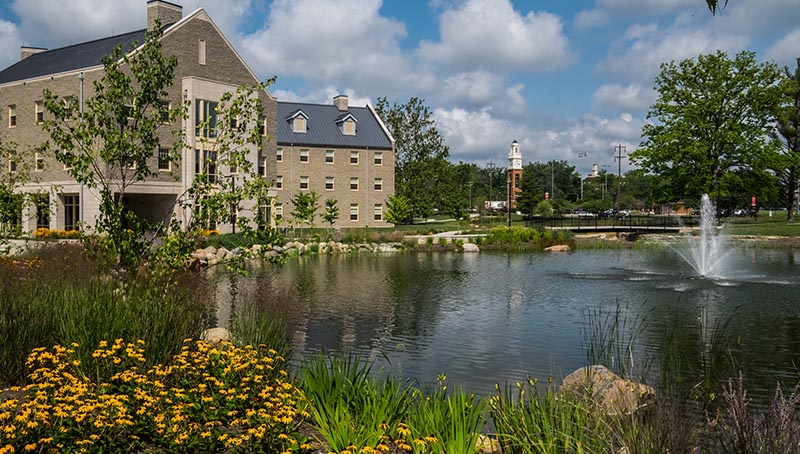

Miami's ponds add beauty, manage stormwater: 300 geothermal wells under ponds are a first in the world

By Susan Meikle, university news and communications
Miami’s new ponds — Western Upper and Lower Ponds and Patterson Pond — work in concert with rain gardens on campus to manage and purify stormwater runoff.
Upper and Lower Ponds are workhorses that provide even more benefits from above and below.
A first use ever of its kind: Geothermal wells under ponds
Upper and Lower Ponds, created in 2014 with the construction of the geothermal well fields and the LEED silver residence halls Beechwood, Hillcrest and Stonebridge on Western campus, have a unique feature:
- Approximately 300 geothermal wells are situated under the ponds — the first time wells have ever been installed under ponds anywhere in the world, according to Doug Hammerle, director of energy systems at Miami.
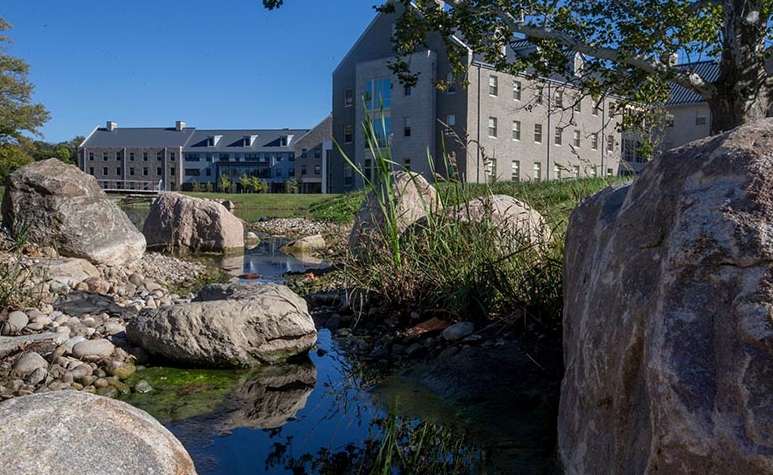
The fountain in Western Upper Pond (top) provides aeration. Water from Lower Pond can be pumped to the Upper Pond through the man-made stream channel, above, to help it maintain a constant level.
- That’s not all: Coils of piping, buried under the sand of Upper Pond, act as a heat exchanger. On hot days, heat is dumped from the pipes into the pond; on cold days, heat is pulled out of the pond. They essentially provide the heat exchange of 30 geothermal wells, Hammerle said.
- And there’s more: Upper Pond collects condensate from air conditioning systems on campus — up to 5,000 gallons can be collected on a hot day.
- Upper Pond is maintained at a constant level by circulating water from Lower Pond.
Upper and Lower Ponds are designed to store and temporarily hold stormwater runoff from surrounding buildings.
- Lower Pond also detains stormwater runoff from a 25-acre area that encompasses Bishop Woods and Cook Field.
- Water from Lower Pond is used to irrigate the natural turf portion of Cook Field when needed.
Patterson Pond
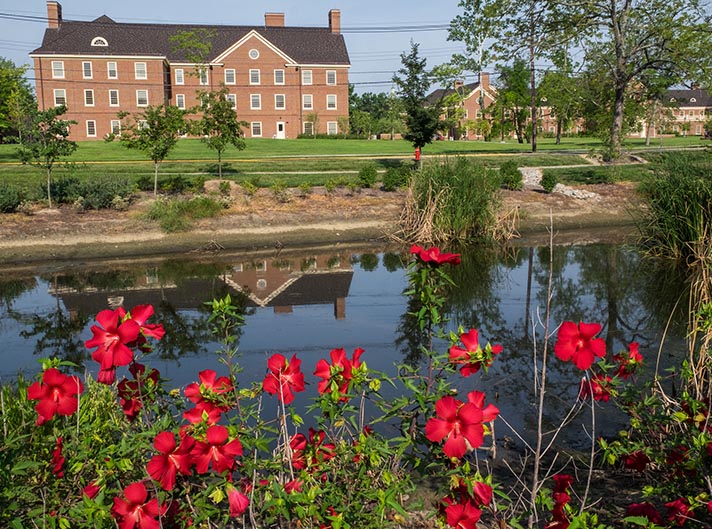
Patterson Pond, facing Tappan Hall (above) and Presser Hall (below) detains stormwater runoff from around MapleStreet Station and other areas.
Created in late 2014, Patterson Pond, located in front of Presser Hall just to the east of Patterson Avenue, detains rainwater that falls around MapleStreet Station, Etheridge Hall and the Center for Performing Arts.
The water level rises and then drops as collected stormwater is released over a 24-to-48-hour period.
MapleStreet Station and Etheridge Hall, and the pavement and patios around them, were constructed in 2013.
With the increase on the Oxford campus in the impervious surface area — from new buildings, sidewalks and parking areas — comes a direct increase in the volume of stormwater runoff to tributaries.
Miami’s stormwater management plan (2011) is part of Miami’s efforts to consider the impacts of capital improvement projects on not only the quality of campus life but also on the natural environment. The plan is grounded in principles of sustainable design and construction.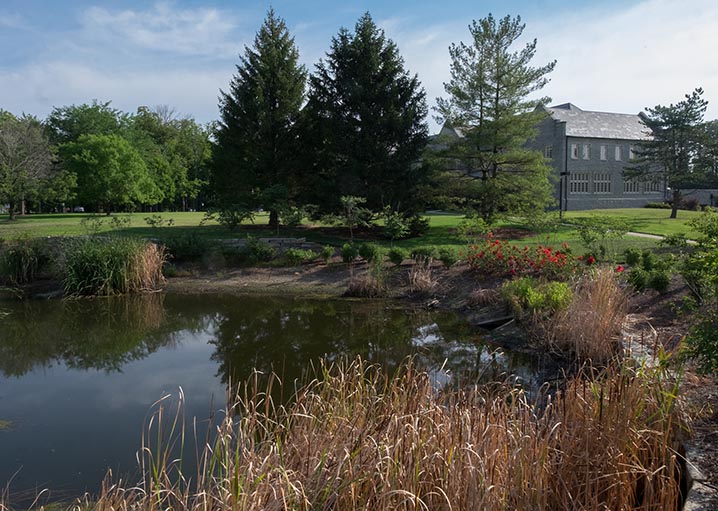
Fourmile Creek Watershed
The Miami University campus lies within the southeastern portion of the Fourmile Creek watershed found in northwest Butler and southwest Preble counties.
Stormwater runoff from roads and parking areas transports pollutants ranging from salts, petroleum byproducts, heavy metals and other contaminants into natural waterways.
Superheated runoff — caused by warm sunny days, rooftops and pavement — can result in harmful effects to the biological habitat of tributary creeks and rivers.
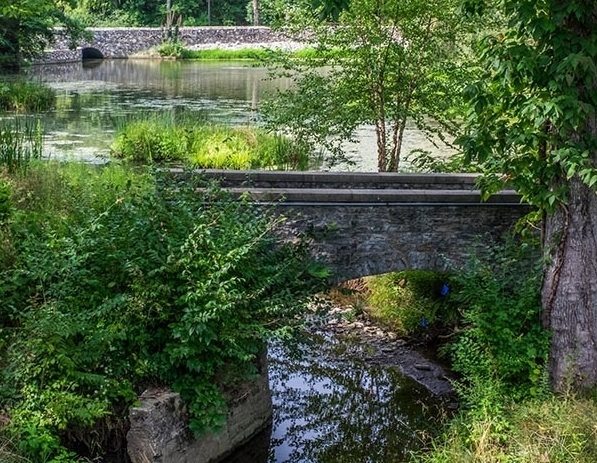 Miami's ponds and rain gardens purify, cool and detain the runoff that flows through storm drains, significantly reducing the amount of pollution and superheated water that flows to creeks. They also provide habitat for wildlife and help keep excess nitrogen runoff from fertilized areas from entering the watershed.
Miami's ponds and rain gardens purify, cool and detain the runoff that flows through storm drains, significantly reducing the amount of pollution and superheated water that flows to creeks. They also provide habitat for wildlife and help keep excess nitrogen runoff from fertilized areas from entering the watershed.
The purified runoff eventually flows into Collins Creek. Collins joins Fourmile Creek downstream; Fourmile joins the Great Miami River.
Western Duck Pond
More than 100 years ago a dam was built on a creek at the bottom of “Peabody Hill” to create Duck Pond on Western campus, which was then the Western Female Seminary, founded in 1853.
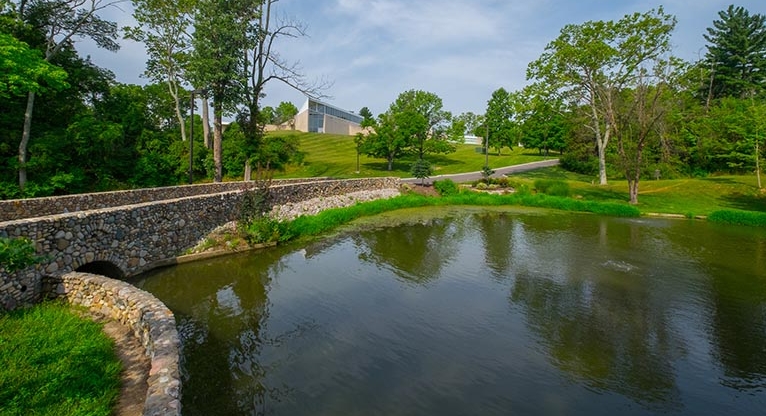
Duck Pond inlet (top) and outlet, which flows to Collins Creek.
Duck Pond was used to supply ice in the years before refrigeration. The original icehouse was converted to a boat house in the early 1900s. Ice skating and boating on the pond were enjoyed by students.
The pond has been enlarged and dredged over the years.
Duck Pond is the final stormwater management feature on campus before water continues downhill to Collins Creek and beyond, ultimately moving to the Gulf of Mexico.
View more images by Scott Kissell of Miami's ponds on the Photoshelter image gallery "Stormwater Management Ponds."![]()
"The rolling hills, ponds and forest of the original 30-acre campus provided a backdrop for the rigorous curriculum students pursued." Western Female Seminary, archives.
Image of Duck Pond, Peabody Hall and Alumnae Hall (1897-1977) below from Special Collections and Archives.

